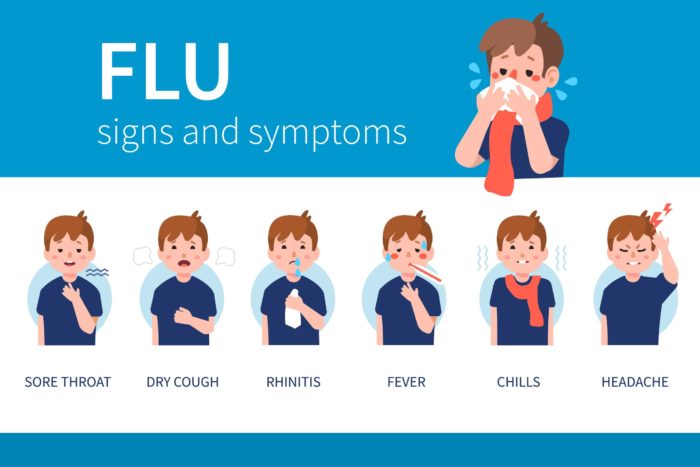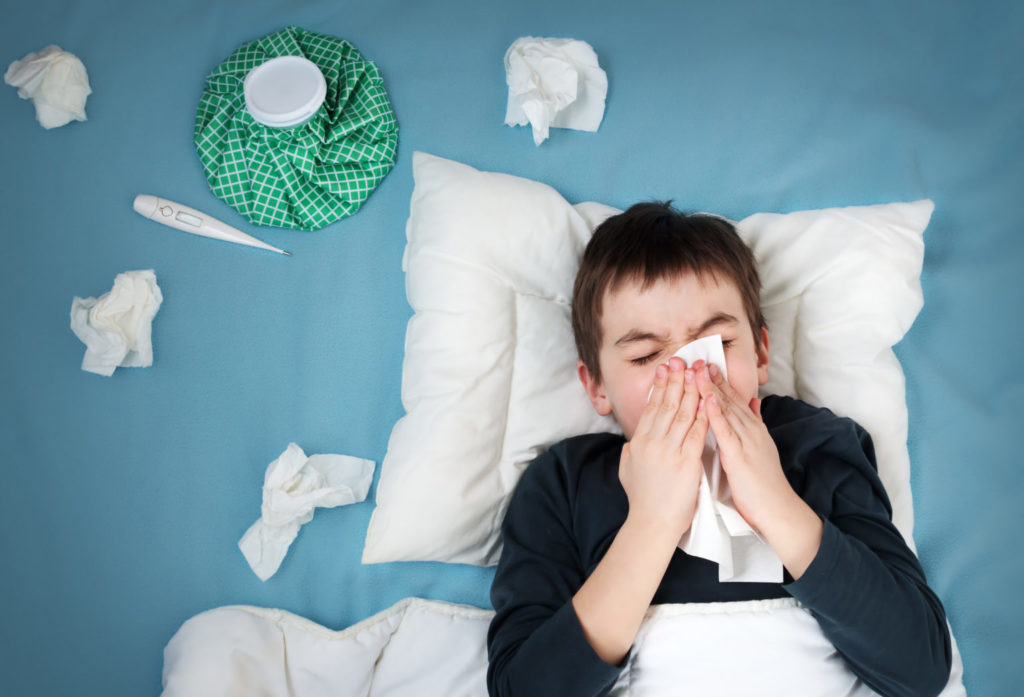Ah, the perplexing and ever-bursty influenza virus – colloquially known as the flu – a respiratory ailment most contagious that afflicts multitudes of millions annually. Little ones find themselves particularly vulnerable to this malady, courtesy of their immune systems yet to reach full bloom and frequent germ encounters in scholarly or daycare environments. Comprehending the impact of influenza on children is imperative for parents and caregivers so they may take suitable actions to prevent its onset while ensuring proper care when symptoms materialize.

Swift identification of these early manifestations can aid in expediting treatment whilst mitigating complications linked with this viral invasion. Indicators suggesting a child might have succumbed to influenza encompass feverish temperatures, coughs, throat soreness, nasal congestion or discharge, bodily aches, head throbs, shivering chills, weariness and occasional bouts of emesis or diarrhea. A vital task for guardians entails not only being cognizant of these symptoms but also grasping how they diverge from those incited by other prevalent childhood ailments such as colds or allergies.
A paramount undertaking in thwarting influenza within young populations involves securing an annual flu inoculation for each child. This preventive potion operates by bolstering their bodies’ defenses against explicit strains insidiously lurking during forthcoming seasons. Although it falls short in providing absolute safeguard against all variants behind illnesses at any given juncture nor wholly eradicates chances of disease acquisition; studies reveal that immunization considerably diminishes severity if infected – feasibly even preserving lives from grave complications like pneumonia or dehydration which could transpire without prompt intervention following emergence initial symptomatology pertaining thereto previously mentioned conditions(s).
Recognizing Symptoms of Influenza in Young Ones
As the season of flu looms near, it becomes essential for guardians to be cognizant of indications and manifestations connected with this ailment in youngsters. Albeit certain signs might mirror those seen during a mundane cold, unmistakable contrasts exist that aid in pinpointing the existence of influenza. By and large, this malady strikes abruptly and presents itself through fever, bodily discomforts, weariness, coughs, tender throats – occasionally accompanied by gastrointestinal troubles like queasiness or regurgitation. Swift identification is key so as to promptly provide suitable remedies.

Offspring experiencing influenza may showcase marginally distinctive indications compared to grown-ups. For instance, elevated fevers could be present or respiratory distress might amplify owing to their tinier air passages. Furthermore, little ones may not always articulate their unease or precisely portray their sensations; thus caregivers must meticulously observe them amid these periods. Parents ought to also remain vigilant if offspring seem atypically fractious or indolent since such behaviors could signify an underlying ailment stemming from the influenza virus.
To defend your progeny against contraction of flu amidst peak seasons, ascertain that they receive annual immunizations against this affliction. The inoculation has demonstrated effectiveness in diminishing both intensity and endurance of illness when dispensed correctly and expediently prior to exposure transpiring. Moreover, adherence to exemplary hygiene practices – frequent hand cleansing along with evading interaction with unwell individuals – will further mitigate probabilities of being afflicted by viral agents responsible for inducing influenza amongst juveniles within collective population contexts – ultimately curtailing possible complications linked with this prevalent juvenile malady
Preventing the Flu: Importance of Vaccination
In the realm of flu prevention for youngsters, vaccination emerges as a remarkably potent strategy. Indeed, the influenza vaccine is heartily endorsed for all children aged 6 months and beyond, with particular emphasis on those facing heightened risk of complications stemming from this ailment. For children under 9 years who lack prior vaccinations or possess an incomplete record thereof, two doses might be warranted. As each flu season heralds new viral strains responsible for influenza infections, securing an annual flu shot remains crucial.
Not only does vaccinating your offspring shield them from succumbing to the flu itself but also curtails their likelihood of grappling with severe symptoms or related complications. Children beset by certain chronic health woes – asthma, diabetes, and heart disease among them – are especially susceptible to such complications and thus warrant priority immunization status. Moreover, when healthy children receive vaccinations en masse in communities at large can yield herd immunity which could lead to diminishing overall cases during peak periods within specific locales.
In spite of prevalent misconceptions suggesting that vaccinations may induce mild instances of illness post-administration; such notions have been thoroughly debunked in relation to procuring yearly influenza shots! While minor side effects like soreness surrounding injection locations or fleeting low-grade fevers might ensue shortly after administration – these pale markedly in comparison to potential hazards posed by full-fledged cases contracted bereft protection proffered through inoculation proceedings themselves! Furthermore
Causes and Transmission: How Kids Catch the Flu
The flu, that highly contagious respiratory ailment, easily leaps from person to person – particularly where children gather in clusters such as schools and daycares. Airborne transmission occurs when an infected individual coughs or sneezes, sending virus-laden droplets into the environment. Inhaling these minuscule particles or touching contaminated surfaces before rubbing their eyes, nose, or mouth can lead to infection for unsuspecting youngsters.
With immune systems not yet fully developed, children are more susceptible to catching the flu than adults. This holds especially true for little ones who have never encountered influenza; their inaugural bout with the virus tends to be harsher than subsequent infections experienced by older kids and grown-ups. Even healthy children may endure serious complications due to unfamiliarity with the viral foe and a lack of immunity development. As flu season commences each year, parents ought to take precautions to keep this unwelcome guest out of their homes.
Influenza’s most formidable foil is vaccination. The Centers for Disease Control and Prevention (CDC) advocates that everyone aged six months and up receive an annual flu vaccine unless contraindicated because of specific medical conditions or allergies. For tots between 6 months old until they reach 9 years old having no previous dose of any seasonal influenza vaccine should get two doses spaced at least four weeks apart during this time frame—except if your child turns nine after July 1st but prior September 30th: they will still require two doses this season even though next year they’ll technically be considered “older” since turning ten would generally mean only one shot annually thereafter . Parents must grasp that vaccines don’t cause the flu; rather they help construct immunity against it so if exposure happens later on , odds are considerably diminished -or intensity abated- compared unvaccinated individuals succumbing illness from influenza . Indeed , research reveals vaccinated youths less likely develop severe consequences arising from influenza also might recuperate more promptly if they do contract the virus.
Potential Complications and Risks for Children
In the realm of pediatric health, a perplexing conundrum arises when considering children with specific chronic conditions – they are at an elevated risk for developing complications from the insidious influenza types A and B. Asthma, diabetes, heart disease or immune system disorders may be among these precarious circumstances. The esteemed Centers for Disease Control and Prevention (CDC) sagely counsel that all young ones aged 6 months and older partake in an annual flu vaccine ritual to safeguard not only their own wellbeing but also shield those around them from the nefarious clutches of flu-related maladies. It is of paramount importance to engage in consultation with your progeny’s healthcare provider regarding their distinctive requirements and potential hazards associated with contracting this seasonal affliction.
The labyrinthine spectrum of complications that may besiege a child afflicted by the flu can span from mild to severe consequences. Amongst possible outcomes are sinus infections, ear infections, pneumonia, dehydration exacerbation of pre-existing medical quandaries such as asthma or cardiac dilemmas seizures induced by elevated fevers in younglings (the phenomenon known as febrile seizures), inflammation afflicting crucial organs like the brain (encephalitis) or muscles (myositis), multisystem inflammatory syndrome in children (MIS-C) – ominously linked to COVID-19 infection following exposure to influenza virus; and even mortality. The CDC fervently declares that obtaining a flu vaccine each solar cycle is indispensable for diminishing these potential perils amongst susceptible demographics.
A formidable apprehension concerning public health ramifications stems from how facilely influenza types A and B wield their influence upon children: transmission within communities transpires effortlessly. Alas! A mere touch could suffice – if a child grazes something tainted by respiratory droplets emanating from an infected person’s coughs or sneezes before touching their ocular orbs, nasal passages or oral cavity schools and daycare centers become fertile breeding grounds propagating illness swiftly amongst familial units. To counteract this formidable risk during apex seasons of concurrent administration of both flu vaccines and COVID-19 vaccines, parents are advised to ascertain that their offspring’s vaccinations remain current whilst simultaneously adhering to commendable hygiene practices such as regular handwashing throughout the diurnal cycle.
Navigating Flu Season: Tips for Parents
In the realm of parenting, a heightened cognizance regarding the ease with which young offspring and those burdened by particular health afflictions can contract the flu virus is indispensable. Such clusters are more prone to an aggravated or convoluted bout of influenza, given that their defenses may lack sufficient robustness to counteract viral invasion effectively. Moreover, discerning whether one’s progeny suffers from the flu proves arduous due to many symptoms stemming from commonplace juvenile maladies; thus, requiring apt medical assessments.
To shield your offspring from potential pernicious consequences associated with influenza – such as otitis media induced by it or amplified risk for complications incited by the pathogen itself – prompt preemptive actions are paramount. One quintessential safeguard involves ensuring timely administration of annual inoculations when new vaccines emerge prior to every flu season’s commencement. Both injectable (flu shots) and nasal spray immunizations constitute viable protections against this ailment.
Besides vaccinations, further approaches exist that may curtail exposure and transmission amid children harboring specific health issues who might endure acute manifestations upon contracting influenza. Parents ought to promote habitual hand hygiene within domestic and educational settings while concurrently instructing their brood on proper cough decorum to mitigate viral dissemination amongst close-knit collectives such as classrooms or playgroups. Fusing these proactive endeavors with yearly immunization enables families to adeptly traverse forthcoming flu seasons whilst prioritizing their offspring’s holistic welfare throughout this temporal span.
Diagnosis and Treatment for Flu-stricken Children
Diagnosing influenza in children can indeed be a perplexing task, as its symptoms often mimic those of other prevalent childhood maladies. Yet, when a child displays flu or flu-like manifestations during the virus’s zenith season, it becomes imperative to promptly seek medical care. Physicians may conduct a swift influenza diagnostic examination (RIDT) for verifying the virus’s presence in infants and youngsters – this test entails procuring a specimen from the throat or nasal cavity using a swab and yields results within 15 minutes.
A cardinal facet of addressing and thwarting influenza in children lies in vaccination. The Centers for Disease Control and Prevention (CDC) advocates that hale children over six months old obtain an annual flu jab for optimal safeguard against the ailment. For specific age brackets like 2-8 years old, healthy juveniles may utilize a nasal spray as an alternative immunization method. It is crucial to acknowledge that some tykes aged between 6 months to 8 years might necessitate another flu vaccine about one month post their inaugural dose if they have never been vaccinated previously or if they haven’t acquired at least two doses since July 1st last year.
Guardians must ascertain that their offspring receive their yearly flu shot well beforehand so that they remain shielded throughout peak seasons with soaring risk factors; ideally, this translates into having them vaccinated by October end each year since it requires approximately two weeks after administration for comprehensive immunity levels to develop within recipients’ systems – thereby furnishing supreme protection amid these intervals wherein hazards linked with contracting illnesses escalate markedly due to heightened circulation of viruses amongst populations globally which frequently culminates in elevated transmission rates especially among susceptible clusters such as neonates below five who have yet to establish potent immune reactions themselves against various strains presently circulating worldwide today\n
Supporting Recovery: Caring for Kids Post-Influenza
As progeny convalesce following an bout of influenza, the indispensability for parental vigilance in symptom surveillance and apt caregiving must not be understated. A pivotal measure to thwart recurring afflictions is the annual bestowal of a flu vaccine upon the child, given the capricious nature of influenza viruses and their incessant strain metamorphosis each annum. However, infants below 6 months are deemed excessively juvenile for flu vaccination; ergo, it becomes imperative that guardians and kin nearby receive immunization to forge a safeguarded milieu.
Influenza tends to assume an acute demeanor in toddlers under two years or those encumbered by pre-existing maladies. Contrasting common colds with their innocuous manifestations like nasal discharge or coughing spells, influenza boasts heightened severity with potential ramifications such as pneumonia or dehydration—both particularly prevalent amongst younger offspring. Consequently, parental acuity in discerning flu symptoms rather than mere cold indicators is absolutely essential.
To bolster recuperation subsequent to an episode of influenza, ascertain your child indulges in ample rest whilst maintaining hydration via persistent fluid intake. Over-the-counter remedies may be employed for tots surpassing specific age milestones (as advised by medical practitioners) to mollify feverishness or discomfort; notwithstanding this fact, refrain from administering these treatments to neonates below six months sans consultation with a physician beforehand. Furthermore, remain vigilant towards any symptom exacerbation or latent complications warranting supplementary clinical scrutiny—swift action could prove indispensable in expediting your young one’s recovery from this malady.

